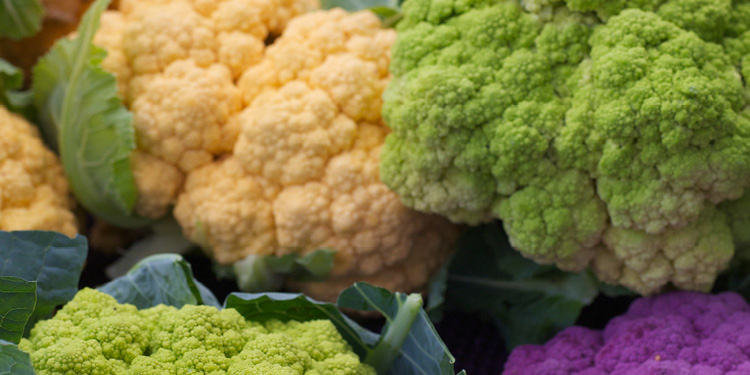


Sign-up for {N}power to get exclusive discounts, newsletters, members-only features, and more!
 Denver - Design District - Alameda and Broadway
Denver - Design District - Alameda and Broadway
368 S Broadway
Denver, CO 80209
United States
 Preferred Store:
Select a Store
Preferred Store:
Select a Store


Cauliflower is not naturally white. As cauliflower matures, exposure to the sun will turn the heads yellowish, greenish and even orangish and purplish. However, somewhere along the way, someone decided that snowy white was the desired color, so farmers hand tie the leaves around the developing head, a processes known as blanching, to block sunlight from reaching it. Newer varieties of “self-blanching” cauliflower have leaves that curl up over the tops of the head naturally and thus do not require tying.
“Training is everything, a peach was once a bitter almond; a cauliflower is nothing but a cabbage with a college education.”
– Mark Twain Puddn’ Head Wilson
Like other members of the cruciferous family of vegetables (broccoli, cabbage, kale), cauliflower is a potent source of glucosinolates—sulfur-containing phytonutrients that the body breaks down into compounds with powerful anti-cancer effects. According to the National Cancer Institute, in animal and cell studies, these compounds have been shown to protect cells from DNA damage; inactivate carcinogens; induce cell death (apoptosis); have anti-inflammatory effects; and inhibit tumor blood vessel formation and tumor cell migration, necessary for metastasis. The glucosinolates also increase the body’s antioxidant defenses and improves the body’s ability to detoxify harmful chemicals and hormones, specifically estrogen. Multiple human studies suggest that a high intake of cruciferous vegetables reduces the risk of several types of cancer, including breast, colon, lung, and prostate. That cauliflower pizza crust is sounding better all the time!
While cauliflower isn’t one of the most heavily sprayed vegetables, it is sprayed with one of the most damaging insecticides—neonicotinoids, the infamous bee killers. Residue results obtained from the USDA Pesticide Data Program show that by far the most common pesticide residue found on conventional cauliflower is a neo-nicotinoid called imidacloprid. The so-called “neonics” are implicated in honey bee colony collapse disorder (CCD), in which bees abandon their hives and eventually die. In a 2014 study Harvard researchers studied several groups of bee colonies, one treated with imidacloprid; another with clothianidin, another neonicotinoid; and a third untreated group that acted as a control. By the end of the research period, half of the colonies treated with neonics were lost, compared with only one non-treated colony. “We demonstrated again in this study that neonicotinoids are highly likely to be responsible for triggering CCD in honey bee hives that were healthy prior to the arrival of winter,” reported lead author Chensheng Alex Lu of the Harvard School of Public Health. If the bees go, then so does cauliflower… and many other fruits and vegetables that rely on honey bees for pollination.



Sign-up for {N}power to get exclusive discounts, newsletters, members-only features, and more!
